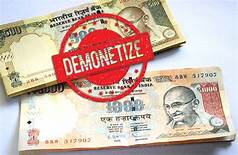Notes Demonetized
The whole country witnessed an unusual announcement from Prime Minister Narendra Modi on November 8, 2016, when he declared that the currencies in the denominations of Rs 500 and Rs 1,000 would be invalid post-midnight. Nevertheless, the denomination of Rs 10, Rs 20, Rs 50, Rs 100 and coins –will be valid. Further, it was announced that the new notes of Rs 500 and Rs 2,000 would be introduced shortly. Thus, giving millions of Indians a panic attack.
However, what do you think was this the first time an Indian currency was banned all of a sudden? Well, the answer is NO. It has happened in the past as well. Demonetisation has been implemented twice in the past.
The First Demonetisation drive:
In the year 1946, denominations of Rs 1,000 and Rs 10,000 were removed from circulation. The ban had no effect on ordinary citizens since the currency of higher denomination was not accessible to the common people. However, strangely both the notes were reintroduced in 1954 with an additional introduction of Rs 5,000 currency. In 1934 currency note of the denomination of Rs 500 and Rs 1000 were introduced and after four years in 1938, Rs 10,000 notes brought into circulation.
The second Demonetisation drive:
Again, in 1978; the Morarji Desai government announced the currency ban taking Rs 1000, Rs 5000 and Rs 10,000 out of circulation. The main objective behind such a move was to curb black money generation in the country.
Similarities in 1978 and 2016 ban:
The note ban introduced by the Morarji Desai government also aimed at driving away black money out of circulation in the economy. As a result, The High Denomination Bank Notes (Demonetisation) Act came into effect.
Prime Minister Modi made public the currency ban in an address that was broadcasted across all news channels. Likewise, Desai took to AIR to announce the note ban after which the banks were closed the following day.
Both affairs were kept confidential.
Differences in the ban:
Unlike Modi, Desai did not have the backing of the RBI Governor. Governor I.G. Patel was of the opinion that the ban was implemented simply to immobilize the funds of the opposition party. Patel has had different views since he believed that people never store black money in the form of currency for too long.
The note ban had a minute impact on the people and affected only the privileged few. While the ban introduced by the Modi government had affected the common, man the most.
There is also a buzz that new currency notes of Rs 500 and Rs 100 with additional features and designs will be introduced very soon. It is similar to the situation in the early 70s when there were rumors of withdrawing Rs 100 note from circulation, and immediately there were long queues at banks to exchange their Rs 10 and Rs 20 currencies. Due to this sudden decision by PM Modi, there is belief in official circles that black money would vanish by abolishing Rs 500 and Rs 1000 currency notes and there is ample hope that the economy will be back on track.




